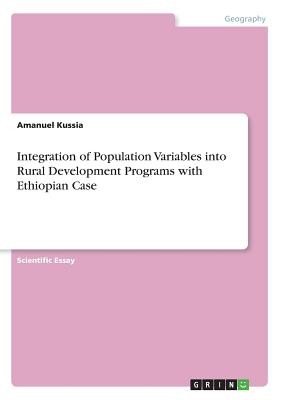
- We will send in 10–14 business days.
- Author: Amanuel Kussia
- Publisher: GRIN Verlag
- Year: 2018
- Pages: 36
- ISBN-10: 3668783721
- ISBN-13: 9783668783720
- Format: 14.8 x 21 x 0.2 cm, minkšti viršeliai
- Language: English
- SAVE -10% with code: EXTRA
Integration of Population Variables into Rural Development Programs with Ethiopian Case (e-book) (used book) | bookbook.eu
Reviews
Description
Scientific Essay from the year 2018 in the subject Geography / Earth Science - Demographics, Urban Management, Planning, language: English, abstract: The main purpose of this essay is to examine the integrations between population variables and rural development in general and food security in particular. A critical review of literature and analysis of secondary data were carried out to understand these dynamic linkages. For all nations, people are the ultimate and the only recipient of development results. Even if the population variables are decisive planning inputs, however, they were ignored and treated as exogenous factors in the process of development planning during the 1950s and 1960s. And so, the resultant problems such as poverty, unemployment, inequality, and other social ills were pervasive and deep-rooted in rural areas of the developing countries. The major reason for this tragedy was belived to be the failure of development theories, policies, and approaches adopted during the 1950s and 60s. It was during the 1970s that the issue of integrating population factors into development planning attracted the attention of some international organizations (such as UN) and vigorously advocated since then. Therefore, so as to balance the pace of the population growth and rural development process, all development actors in Ethiopia should adopt holistic and synergetic approaches in such a way that enhance agricultural productivity and boost investment in rural social and physical infrastructures.
EXTRA 10 % discount with code: EXTRA
The promotion ends in 21d.20:58:27
The discount code is valid when purchasing from 10 €. Discounts do not stack.
- Author: Amanuel Kussia
- Publisher: GRIN Verlag
- Year: 2018
- Pages: 36
- ISBN-10: 3668783721
- ISBN-13: 9783668783720
- Format: 14.8 x 21 x 0.2 cm, minkšti viršeliai
- Language: English English
Scientific Essay from the year 2018 in the subject Geography / Earth Science - Demographics, Urban Management, Planning, language: English, abstract: The main purpose of this essay is to examine the integrations between population variables and rural development in general and food security in particular. A critical review of literature and analysis of secondary data were carried out to understand these dynamic linkages. For all nations, people are the ultimate and the only recipient of development results. Even if the population variables are decisive planning inputs, however, they were ignored and treated as exogenous factors in the process of development planning during the 1950s and 1960s. And so, the resultant problems such as poverty, unemployment, inequality, and other social ills were pervasive and deep-rooted in rural areas of the developing countries. The major reason for this tragedy was belived to be the failure of development theories, policies, and approaches adopted during the 1950s and 60s. It was during the 1970s that the issue of integrating population factors into development planning attracted the attention of some international organizations (such as UN) and vigorously advocated since then. Therefore, so as to balance the pace of the population growth and rural development process, all development actors in Ethiopia should adopt holistic and synergetic approaches in such a way that enhance agricultural productivity and boost investment in rural social and physical infrastructures.


Reviews